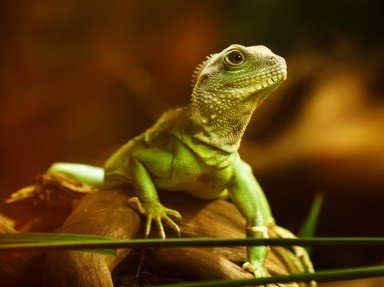Quiz Answer Key and Fun Facts
1. How much does the average wild adult Komodo dragon weigh?
2. Komodo dragons mate once a year, but if a suitable male isn't around the female can asexually reproduce. However, what is rather unusual about the young she creates by herself?
3. While Komodo dragons will happily eat any carrion they find, they also will hunt for food. What is the dragon's preferred hunting method?
4. The mighty Komodo dragon is able to eat an entire goat as one meal! Which is NOT true about this remarkable feeding process?
5. Why do Komodo dragons spend most of their early life living in trees?
6. Which type of tissue makes up the osteoderm bumps under the adult Komodo dragon's skin?
7. Komodo dragons will eat as a group if a meal is large enough. When this happens which dragon will eat first?
8. Herpetologist Bryan Fry disagrees with the common theory that Komodo dragons have deadly bacteria in their mouths. He theorizes the dragons use venom to kill prey instead. Which is NOT one of Bryan's supporting reasons for this theory?
9. In 1980, Indonesia formed the Komodo National Park to help protect the vulnerable dragons. Which of the following reasons does NOT contribute to the dragon's decline in population?
10. Many scientists visit Komodo island and do research there, but can tourists also visit the island and see the Komodo dragons?
Source: Author
BigTriviaDawg
This quiz was reviewed by FunTrivia editor
rossian before going online.
Any errors found in FunTrivia content are routinely corrected through our feedback system.

